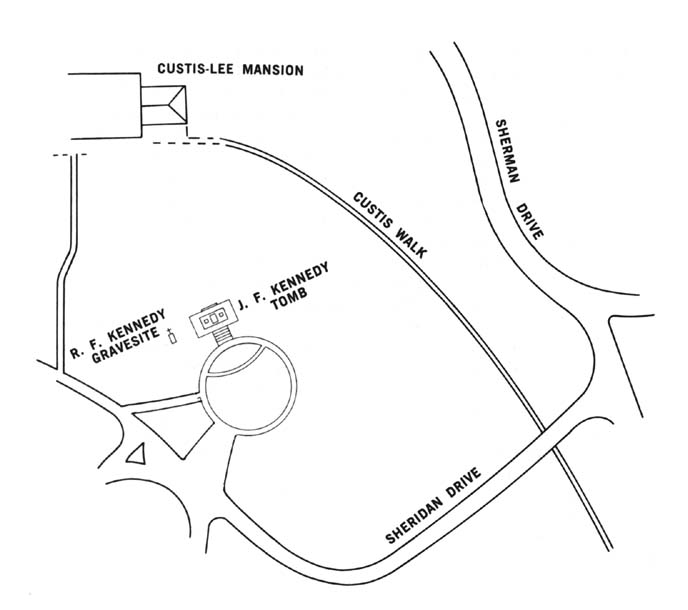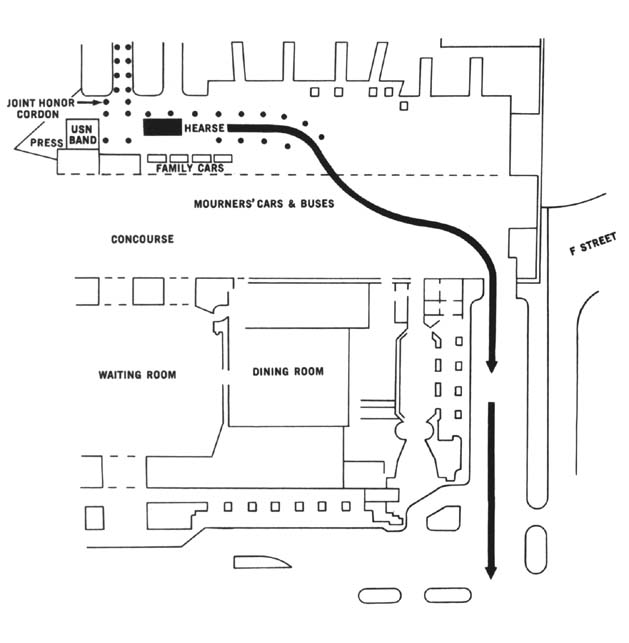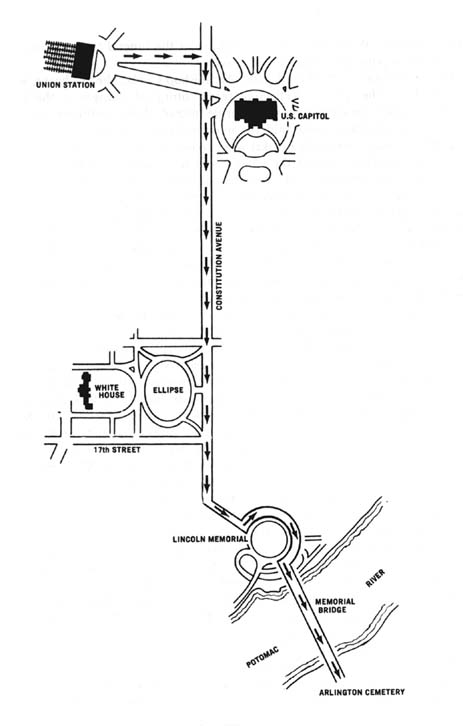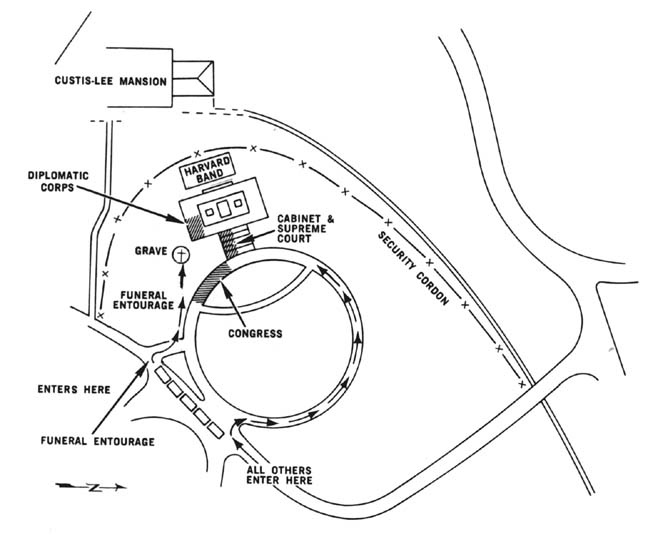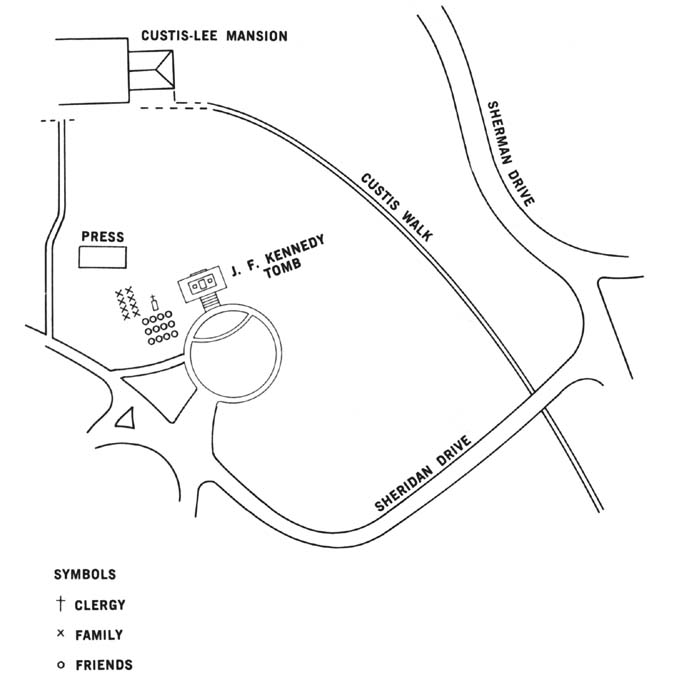The Last Salute: Civil and Military Funeral, 1921-1969
CHAPTER XXVIII
Senator Robert F. Kennedy
Funeral Without Formal Classification
5-8 June 1968
During the first minutes of Wednesday, 5 June 1968, Senator Robert F.
Kennedy, while campaigning for nomination as candidate for the Democratic
party in the coming Presidential election, was shot and critically wounded
by an assassin in the Ambassador Hotel in Los Angeles, California. Senator
Kennedy was rushed to Good Samaritan Hospital in Los Angeles, but intensive
efforts failed to save his life. He died at 0144 (Pacific daylight time)
on 6 June.
As it became less and less likely that the medical efforts to save Senator
Kennedy would succeed, his brother, Edward, a brother-in-law, Stephen
Smith, and a close friend, John Seigenthaler, outlined a funeral and burial
plan. The plan called for a requiem mass at St. Patrick's Cathedral in
New York City, the movement of the senator's body to Washington, D.C.,
by train, and burial in Arlington National Cemetery, all to take place
on Saturday, 8 June. Ethel Kennedy, the widow, approved this outline shortly
after her husband's death. The family then completed plans to take Senator
Kennedy's body to New York City.
Upon receiving the news of Senator Kennedy's death, President Lyndon B.
Johnson in Washington directed that all flags on federal buildings, installations,
and naval vessels in the United States and abroad be flown at half-staff
until after the senator's burial and proclaimed Sunday, 9 June, a day
of national mourning. After learning later that burial would take place
on 8 June, he extended the period in which flags were to be at half-staff
to include the day of mourning.
When the President was informed of the general plan for the funeral ceremony
for Senator Kennedy, he ordered an Air Force 707 jet transport sent to
Los Angeles to carry the body, members of the Kennedy family, and close
friends to New York City. The transport reached the Los Angeles terminal
in time for an early afternoon return flight on 6 June. With the body
and more than seventy people aboard, the plane touched down at La Guardia
Airport at 2057 (eastern daylight time).
During the afternoon of the 6th, Secretary of Defense Clark M. Clifford
formally directed that military support be furnished Senator Kennedy's
family in connection with the funeral and designated the Department of
the Army as the agency primarily responsible. Within the Office of the
Secretary of Defense, the
[324]
official in charge was Alfred B. Fitt, Assistant Secretary of Defense
for Manpower and Reserve Affairs. Under Secretary of State Nicholas deB.
Katzenbach was to work with Mr. Fitt and together they would coordinate
funeral arrangements and provide liaison between the Kennedy family and
authorities in Washington. The work of making ceremonial arrangements
fell to the Military District of Washington.
Early on 6 June, in anticipation of the task eventually assigned to the
Army, Maj. Gen. Charles S. O'Malley, Jr., commanding the Military District
of Washington, opened a funeral operations center at his headquarters
and established liaisons with other agencies that were likely to be called
upon to participate in the funeral arrangements. As had been the case
in 1963 when President John F. Kennedy was assassinated, no contingency
funeral plans for Senator Kennedy existed, and again planning would have
to be completed within a short time and started with little direct contact
with the next of kin.
During the morning of the 6th, before the wishes of the next of kin were
known, the Chief of Staff and other officials briefed Secretary of the
Army Stanley R. Resor on the funeral arrangements. At the same time, the
extent of military participation and the question of whether the senator's
body should lie in state in the rotunda of the Capitol were discussed.
Subsequently, Barrett E. Prettyman, Jr., a Washington attorney and close
friend of the Kennedy family, delivered to Washington officials a message
from Mrs. Kennedy: she wished a minimum of military participation in the
ceremonies and did not favor a lying in state ceremony at the Capitol.
Mr. Prettyman, along with Herbert Schmertz of Senator Kennedy's Washington
office represented the Kennedy family during the planning of the Washington
ceremonies and would handle the details of the arrival of Senator Kennedy's
body in Washington and the movement to Arlington National Cemetery. Military
officials would be in charge of only those ceremonies taking place inside
the cemetery.
At a time when the exact military support that the Kennedy family would
require in either New York City or Washington was still unknown, Paul
C. Miller of the Military District of Washington, Maj. Robert C. Bacon
of the Office of the Army Chief of Staff, John C. Metzler, the superintendent
of Arlington National Cemetery, Mr. Fitt from the Office of the Secretary
of Defense, and Robert E. Jordan III, Special Assistant to the Secretary
of the Army for Civil Functions, met at Arlington National Cemetery. They
considered four possible gravesites for Senator Kennedy, all of them in
the vicinity of President Kennedy's grave, and took pictures which could
be useful to the widow or her representative in making a final choice.
The group next met in Mr. Metzler's cemetery office to discuss possible
ceremonies in Washington for Senator Kennedy, in particular, ceremonies
at the cemetery. During the discussion, Mr. Metzler mentioned that a precedent
existed for holding no ceremonies, in Arlington National Cemetery beyond
1500 on Satur-
[325]
days and asked by what means this precedent could be broken. Mr. Jordan
replied that the large audience anticipated for the graveside rites was
sufficient justification for holding the ceremony after the traditional
closing hour. He also pointed out that holding the ceremony late Saturday
would prevent rescheduling other funerals for the following week.
Since Senator Kennedy had served as a seaman in the Navy, Mr. Miller recommended
Navy Special Full Honor ceremonies, which included use of Navy body bearers,
a Navy firing squad, and a Navy bugler. The decision could not be made,
however, until the wishes of the next of kin were known. Lt. Col. Hugh
G. Robinson, an Army officer, had been sent on the plane to Los Angeles
by the President to act as military aide to the family, and it was hoped
that he would soon provide the needed information.
Mr. Fitt himself was scheduled to fly to New York City later in the afternoon
of the 6th and would be at La Guardia Airport to meet the plane bringing
the body of Senator Kennedy and the Kennedy family from Los Angeles. He
had wanted to take with him the full plans for ceremonies in Washington,
but, as Mr. Miller explained, plans could not be completed until the wishes
of the next of kin were known. As an alternative, Mr. Miller proposed
that Lt. Col. Robert H. Clark, from the Ceremonies and Special Events
Office of the Military District of Washington, should accompany Mr. Fitt
to New York to advise him and the Kennedy family during any discussion
of the Washington ceremonies. Further, Mr. Miller promised to arrange
for military participation in the ceremonies in New York if the Kennedy
family wished. As it turned out, the only family request was made by Senator
Edward M. Kennedy, who asked for four members of the Army Special Forces
(Green Berets) to serve with an otherwise civilian guard of honor at the
bier while the body lay in St. Patrick's Cathedral. On 7 June four Special
Forces sergeants arrived in New York from Fort Bragg, North Carolina,
to complete the guard of honor.
Mr. Fitt, accompanied by Mr. Katzenbach of the Department of State and
Colonel Clark, left Andrews Air Force Base for New York City at 1730 on
the 6th. Landing at Kennedy Airport, Mr. Fitt and Colonel Clark remained
there to meet the plane bearing former Secretary of Defense Robert S.
McNamara, now president of the World Bank, and his wife, who were coming
from Europe to attend the Kennedy rites. Mr. Katzenbach meanwhile went
into the city to Kennedy Campaign Headquarters at 200 Park Avenue, where
a meeting with members of the Kennedy family would be held later.
Mr. and Mrs. McNamara arrived at 2000 and went with Mr. Fitt and Colonel
Clark to La Guardia field. Also there to meet the Air Force plane bearing
Senator Kennedy's body were New York Governor Nelson A. Rockefeller, New
York Senator Jacob K. Javits, Mayor of New York City John V. Lindsay,
and U.S. Representative to the United Nations Arthur Goldberg. About a
thousand persons watched the proceedings from behind a fence some 200
feet away.
[326]
When the plane arrived, the Kennedy family stood close by as the casket,
handled by persons who had accompanied the body from Los Angeles, was
taken off the plane. There was a pause while Archbishop Terrence J. Cooke
of New York delivered a prayer. The casket was then placed in the hearse,
the family, friends, and dignitaries entered automobiles, and the cortege
proceeded to St. Patrick's Cathedral. When it arrived about 2145, Archbishop
Cooke offered another prayer as the casket was carried up the steps. Afterward
Senator Kennedy's body was taken inside and the archbishop conducted a
short service. Most of the people who had been in attendance then left
the cathedral, but some took post at Senator Kennedy's bier as a guard
of honor.
After the cathedral ceremony, Edward Kennedy, Stephen Smith, Mr. Fitt,
Mr. Katzenbach, and Colonel Clark conferred at Kennedy Campaign Headquarters
on the ceremonies to be held in Washington, especially on the extent of
military participation. The family representatives presented their plans
to take Senator Kennedy's body in a motorcade from Union Station to Arlington
National Cemetery. En route the procession was to pause at the Department
of Justice building on Constitution Avenue in recognition of Senator Kennedy's
position as Attorney General during his brother's tenure as President;
a second pause was to be made at the Lincoln Memorial, where a choir was
to sing. The family representatives asked that a military band, joint
service honor cordon, and Navy body bearer team meet the funeral train
at Union Station, but they wanted no military escort or other troops in
the procession to Arlington National Cemetery. Nor did they wish military
participation or support at the cemetery beyond that required for traffic
control. They also announced that they were making arrangements to have
the Harvard University Band participate in the graveside rites. During
the meeting there was some discussion of the selection of the gravesite
but no final decision was made.
Mr. Fitt, Mr. Katzenbach, and Colonel Clark returned to Washington after
this meeting. Before leaving New York, Mr. Fitt instructed Colonel Clark
to take the precaution of having a Navy body bearer team stand by in Arlington
National Cemetery at the time of the burial rites. Arriving at Andrews
Air Force Base at 0330 on 7 June, the three men had all the necessary
information for detailed planning of the funeral except the choice of
the cemetery plot.
Mrs. Kennedy selected a gravesite late on 7 June. During the day Mr. McNamara
had flown to Washington, inspected the four recommended sites, and returned
to New York City to present his findings to the widow. Mrs. Kennedy then
chose the site, which, when viewed from President Kennedy's grave, was
just to the left. (Diagram 110) Her choice was communicated to
Washington officials at 2200 on the 7th.
During several meetings held on the 7th meanwhile, the Washington planners
completed the work of setting the sequence and composition of the ceremonies
in Washington and of designating the military units that would participate.
The fu-
[327]
Diagram 110. Location of the gravesite.
neral train from New York was scheduled to reach Union Station in Washington
about 1620 on 8 June. One section of cars bearing dignitaries, family
friends, members of the Kennedy staff, and members of the press was to
arrive first on Track 16; the second section, the funeral car and cars
bearing the Kennedy family and close friends, was to arrive next on Track
17. A Navy body bearer team of eight, supervised by a petty officer, from
the Ceremonial Guard, Naval District Washington, was to wait on the platform.
The casket was to be removed through a window of the funeral car by persons
inside the car; the Navy body bearers were to receive it, carry it halfway
through a joint service honor cordon, then halt to wait for all passengers
to leave the train.
The honor cordon of 211 officers and men was to be provided in almost
equal contingents by the 3d Infantry, Fort Myer, Virginia; the Ceremonial
and Guard
[328]
Company , Marine Barracks, Washington; the Ceremonial Guard, Naval District
Washington; the Air Force Honor Guard, Bolling Air Force Base, Washington;
and the Coast Guard Ceremonial Honor Guard from Washington Radio Station,
Alexandria, Virginia. An officer from the 3d Infantry would command the
cordon troops.
When all passengers had left the train and after the family group had
reached a position near the hearse, the body bearers were to carry the
casket to the hearse while the US Navy Band, standing near the hearse,
was to play the Navy hymn "Eternal Father, Strong to Save."
After Senator Kennedy's casket had been placed in the hearse, the body
bearer team was to step aside as the family and others in the funeral
party entered automobiles for the motorcade to Arlington National Cemetery.
Including site control officials and supporting troops, all from the 3d
Infantry, the officers and men performing duty during the arrival ceremony
at Union Station would total 299. (Table 37)
In deference to the wishes of the Kennedy family, no military units would
move with the procession to the cemetery. During the march ten musicians
from the U.S. Marine Band were to accompany two local choirs that the
Kennedy family had arranged to have sing together at the Lincoln Memorial
when the motorcade paused there.
On the other hand, a large number of troops would assist civil police
units in securing the route of march as far as the cemetery gate. District
of Columbia civil authorities had requested 1,390 members of the District
of Columbia National Guard, 1,284 from the Army, and 106 from the Air
Force, who were to assemble for training early on 8 June at the District
of Columbia Armory and at Camp Sims, the guard training camp in Southeast
Washington. (Table 38) In addition, the Military District of Washington
was to furnish 300 members of the active
TABLE 37-TROOP LIST, ARRIVAL CEREMONY
AT UNION STATION,
WASHINGTON, D.C., FOR SENATOR ROBERT F. KENNEDY
|
Duty
|
US Army
|
US Marine
Corps |
US Navy
|
US Air
Force |
US Coast
Guard |
Total
|
||||||
|
Offi-
cers |
En-
listed Men |
Offi-
cers |
En-
listed Men |
Offi-
cers |
En-
listed Men |
Offi-
cers |
En-
listed Men |
Offi-
cers |
En-
listed Men |
Offi-
cers |
En-
listed Men |
|
| Honor cordon |
1
|
50
|
|
42
|
|
42
|
|
42
|
|
34
|
1
|
210
|
| Body bearers |
|
|
|
|
|
9
|
|
|
|
|
|
9
|
| Band |
|
|
|
|
1
|
48
|
|
|
|
|
1
|
48
|
| Site control |
2
|
1
|
|
|
|
|
|
|
|
|
2
|
1
|
| Press cordon |
|
11
|
|
|
|
|
|
|
|
|
|
11
|
| Medical support |
1
|
7
|
|
|
|
|
|
|
|
|
1
|
7
|
| Door openers |
1
|
7
|
|
|
|
|
|
|
|
|
1
|
7
|
| Total |
5
|
76
|
|
42
|
1
|
99
|
|
42
|
|
34
|
6
|
293
|
[329]
TABLE 38-SUPPORTING NATIONAL GUARD UNITS, WASHINGTON,
DC,
CEREMONY FOR SENATOR ROBERT F. KENNEDY
|
|
|
| District of Columbia Army National Guard | |
| Headquarters and Headquarters Detachment, District
of Columbia Army National Guard Headquarters and Headquarters Detachment, 260th Military Police Group Headquarters and Headquarters Detachment, 163d Military Police Battalion Company A, 163d Military Police Battalion Company B, 163d Military Police Battalion Company C, 163d Military Police Battalion Company D, 163d Military Police Battalion Headquarters and Headquarters Detachment, 171st Military Police Battalion Company A, 171st Military Police Battalion Company B, 171st Military Police Battalion Company C, 171st Military Police Battalion 104th Light Maintenance Company 115th Evacuation Hospital 140th Engineer Detachment 257th Army Band |
|
| District of Columbia Air National Guard | |
| 231st Mobile Communications Squadron 231st Flight Facilities Flight |
|
|
|
|
armed forces to participate in safeguarding the route.
These Regulars, most of the National Guard troops, 900 Metropolitan
Police, and Washington's entire Park Police force were to cordon the
full route from Union Station to Memorial Gate of the cemetery. Part
of the National Guard contingent was to constitute a reserve force available
in the event of civil disturbances.
Some 350 officers and men of the 3d Infantry were to support the ceremonies
at Arlington National Cemetery; most of them — three companies
— were to form a security cordon surrounding a large area centered
on the gravesite. (Diagram 111) The others were assigned to traffic
control or were to assist members of the funeral party. Two platoons
of the 3d Infantry were to stand by at Fort Myer in case of civil disturbance.
Also, as Mr. Fitt had directed, eight Navy body bearers were to be on
hand near the gravesite, prepared to carry the casket from the hearse
to the grave if their help was requested. Finally, in a precautionary
move that proved unnecessary, the Military District of Washington on
8 June alerted the US Army Band to be prepared to play at the graveside
if the Harvard University Band was unable to be present.
Besides the troops, an important feature of military support arranged
for the ceremonies in Washington was motor transportation. Under the
supervision of the Military District of Washington, forty-six passenger
cars, twenty-five buses, five
[330]
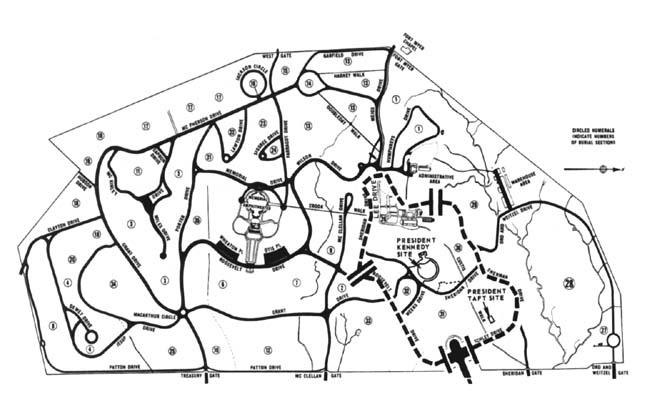
Diagram 111. Cordon at the gravesite, Arlington National Cemetery.
station wagons, two trucks, and an ambulance were reserved for the ceremonies.
These included limousines, sedans, and 45-passenger buses for transporting
the Kennedy family and others in the funeral party to and from Arlington
National Cemetery, buses of varying capacity for carrying members of the
press to and from the ceremonial sites, and vehicles to meet the transportation
needs of various officials and dignitaries. The motor pools at Fort Myer,
Fort McNair, and the Army Service Center for the Armed Forces supplied
most of the vehicles, and drivers were provided from the same sources.
Some commercial buses were chartered. Eventually, five civilian and
eighty military drivers were employed; twenty-eight additional military
drivers were held in readiness but were not used.
Preparations were made to set up audio systems at the Lincoln Memorial
to carry the choir music and at Arlington National Cemetery for the graveside
service. Six Army photographers were assigned to cover the ceremonies,
two each to be posted at Union Station, the entrance to the cemetery,
and the gravesite. Army engineers were to erect press stands and to install
electric circuits at Union Station and Arlington Cemetery. In addition,
arrangements were made with the telephone company to put in lines at the
ceremonial sites.
The method by which the motorcade from Union Station to the cemetery was
to be televised received special attention. Network representatives would
have preferred to broadcast the event as they would have an inaugural
parade, that is, to employ mobile units on the streets, one at the head
of the cortege and others
[331]
"wrapped around" it. But military officials restricted coverage
to cameras in fixed locations or carried along the sidewalks, a restriction
that also had been applied to televising President Kennedy's funeral
procession.
In New York City, where Senator Kennedy's body lay in St. Patrick's Cathedral,
long lines of people passed by the bier until 0500 on 8 June, when the
cathedral was closed to the public in preparation for the pontifical requiem
mass. Invitations to the mass had been extended by the Kennedy family
and its representatives to more than 2,000 persons, including President
and Mrs. Johnson, Vice President and Mrs. Hubert H. Humphrey, government
and military officials, professional people, and friends. Of those attending
the mass, some 700 were invited to travel in the funeral train to Washington
and to be present at the graveside rites. President and Mrs. Johnson and
Vice President and Mrs. Humphrey, who
Diagram 112. Arrival ceremony, Union Station.
[332]
were to return to Washington by air, would meet the funeral train at
Union Station and accompany the cortege to the gravesite.
The mass began at 0955 on 8 June. Archbishop Cooke, the celebrant, was
assisted by four other priests. Reflecting recent liturgical changes in
the Roman Catholic Church, the clergymen wore purple instead of the traditional
black vestments and Archbishop Cooke said the mass in English. When the
mass ended, about 1035, Senator Kennedy's casket was carried out of the
cathedral by thirteen bearers, among them a son of the senator and the
senator's brother, Edward. A cortege of seventy-five cars made the fifteen-minute
trip to Pennsylvania Station, the widow and the senator's brother riding
in the hearse. At the station, after the casket was placed in the funeral
car, the family, friends, associates, dignitaries, and newsmen, numbering
about 1,000, boarded the 21-car train. The train was scheduled to leave
at 1230 and to arrive in Washington at 1620. But because crowds of people
lined the railroad right of way to pay their respects, the train started
late and traveled at a slower pace than was expected. Its posted time
of arrival in Washington became later and later.
In Washington the troops who were to participate in the arrival ceremony
at Union Station were in place by 1600. By that hour it was clear that
the funeral train would be late, and at 1645 General O'Malley, the commander
of the Military District of Washington, arranged to have the troops
at the station fed.
As the waiting time lengthened, making it obvious that the Washington
ceremonies would take place after dark, the Kennedy family made a final
request. From the funeral train, which was equipped with radiotelephones,
Mr. Katzenbach called Mr. Fitt in his Washington office at 1900 to submit
the family's request for 200 torches to be used at the gravesite. Since
torches were not available, 200 candles were obtained from Fort Myer and
1,500 from St. Matthew's Cathedral; these were delivered to the cemetery
about 2000. Army technicians also installed a bank of floodlights to illuminate
the gravesite.
After a delay of almost five hours, the funeral train reached Washington
at 2109. Within twenty minutes the train was brought into Union Station
in two sections, the one with the funeral car and the cars carrying the
Kennedy family, aides, and close friends on Track 17. The Navy body bearers
waited nearby on the platform, which was covered by a red carpet extending
to the station concourse where the honor cordon, the U.S. Navy Band, and
the hearse were in position. President and Mrs. Johnson and Vice President
and Mrs. Humphrey, who had arrived at the station by limousine a few minutes
earlier, reached the ceremonial area about 2130. (Diagram 112)
At Track 17 the family, aides, and close friends left the train first.
Then thirteen bearers, twelve of Senator Kennedy's friends and his son
Robert, brought the casket off the train and carried it toward the concourse.
For some reason the Navy body bearers were not used.
The Navy Band played the Navy hymn "Eternal Father, Strong to Save"
as
[333]
Diagram 113. Route of march, Union Station to Arlington National Cemetery.
[334]
the casket was borne through the honor cordon and placed in the hearse.
Afterward, President Johnson, Vice President Humphrey, and other dignitaries
spoke briefly with the widow and other members of the family. Mrs. Kennedy,
her eldest son, Joseph, and the senator's brother, Edward, then got into
the hearse; the others entered automobiles for the procession to Arlington
National Cemetery.
The route to the cemetery was heavily lined with police and troops. Some
police had taken position on the roofs of buildings verging on the road
of march. The procession moved on 1st Street, N.E., then right on Constitution
Avenue to the Department of justice building, where it paused briefly.
It then continued on Constitution Avenue, turned left on Henry Bacon Drive
to reach the Lincoln Memorial, and moved clockwise around the memorial
to the steps, where it came to a second halt. During a pause of four minutes,
the choir on the steps of the Lincoln Memorial, backed by the brass section
of the US Marine Band, sang
Diagram 114. Movement of cortege, Memorial Gate to the gravesite.
[335]
"The Battle Hymn of the Republic." Several thousand people
had assembled on the grounds around the memorial. Among them were some
of the residents of Resurrection City, the symbolic shanty town that had
been erected on the nearby mall under the sponsorship of the Southern
Christian Leadership Conference as part of the organization's civil rights
program. The procession then continued around the memorial, crossed Memorial
Bridge, and entered Arlington National Cemetery. Mr. Metzler, the cemetery
superintendent, met the motorcade at Memorial Gate to guide it to the
gravesite. (Diagram 113)
Diagram 115. Formation at the graveside.
[336]
The cortege moved through the cemetery via Schley, Sherman, and Sheridan
Drives. Mr. Metzler, with assistance from the 3d Infantry traffic control
detail, guided the cars to positions on Sheridan Drive adjacent to the
grave of President Kennedy. He stopped the hearse and cars bearing the
family, aides, and close friends beside the walkway nearest the gravesite
chosen for Senator Kennedy. Other cars in the cortege were halted farther
to the rear; their passengers were to reach the gravesite by way of the
circular walk in front of President Kennedy's grave. Earlier, persons
not in the cortege but attending the burial service had arrived in
cars and buses and had been guided to graveside positions. (Diagram
114)
The family, aides, and close friends left their cars and moved to positions
behind the hearse. After all were assembled there, the friends and son
of Senator Kennedy who had been acting as body bearers removed the casket
from the hearse. Guided by Mr. Metzler and preceded by the clergy, they
bore the casket to the gravesite, the family and other mourners following.
When those accompanying the casket had reached their graveside positions,
Archbishop Cooke of New York and Cardinal Patrick O'Boyle of Washington,
read the brief burial service. (Diagram 115) At the close the body
bearers, assisted by astronaut Col. John H. Glenn, folded the flag that
had draped the casket. Colonel Glenn presented the flag to Senator Kennedy's
eldest son, Joseph, who handed it to his mother. To conclude the graveside
rites, the Harvard University Band played "America the Beautiful"
while the Kennedy family and other mourners, carrying lighted candles,
went up to the casket to pay their last respects.
The funeral for Senator Robert Kennedy conformed to no prescribed rules;
except for the arrival ceremony at Union Station, it followed none of
the precedents for an Official Funeral. It was rather a ceremony that
reflected the effort of the nation to pay respect to Senator Kennedy in
accordance with the wishes of his family.
[337]
